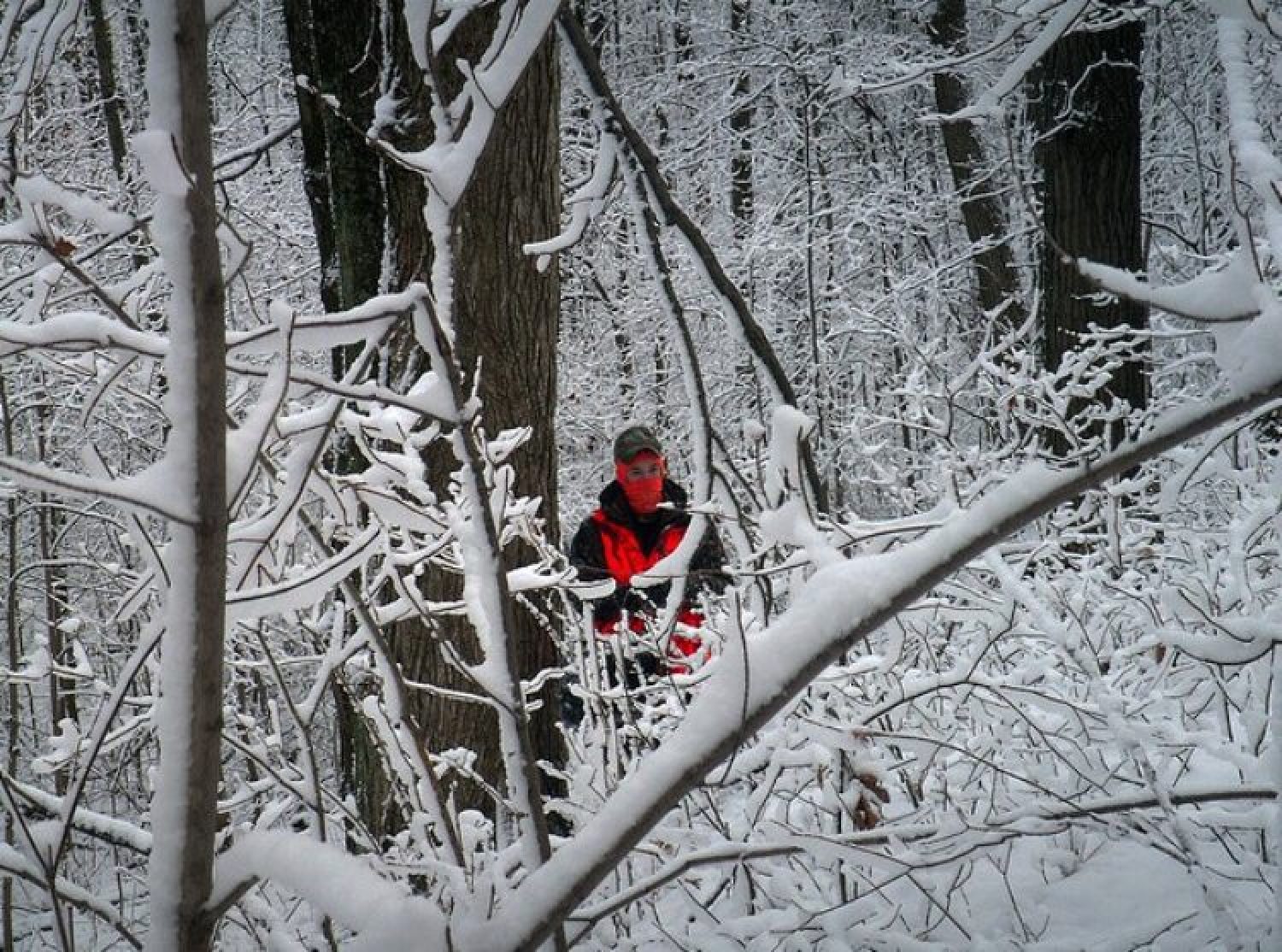When the temperatures drop, it's time to pack up your bags and head back to the hide or driven hunt. After all, who wants to hunt when their shooting fingers are stiff with cold, their feet are a solid lump of ice, and they can't see through the glass properly because they're shivering so much? To prevent your passion from plummeting as much as the temperatures, here are a few tips for keeping yourself warm and dry.
It's not just young hunters who make the mistake of dressing incorrectly for winter hunting. The cold is felt first in the hands and feet. These parts of the body are furthest from the heart – and therefore stop warming up more quickly when outside temperatures drop than, for example, in the middle of the body. What's the best way to protect yourself from cold shock when sitting in a hide or on a driven hunt? Unfortunately, there is no general solution that applies to every hunter. Everyone's sensitivity to cold and their threshold for freezing are too different for that. But there are a few tricks to enjoy the hunt despite sub-zero temperatures. Choose the option that works best for you or simply try something new. Your hands and feet will thank you with a pleasantly warm feeling.
HUNTING BOOTS FOR WINTER
In our latitudes, winter temperatures generally don't reach arctic levels. However, a few degrees below zero can be just as unpleasant as a driven hunt at -10 degrees Celsius. Moreover, it's not just the actual cold that plays a role in feeling cold. Humidity and wind also negatively affect body heat, depending on the circumstances. And, as already mentioned, the subjective feeling of cold shouldn't be ignored. It's not for nothing that weather reports on the radio now refer to "perceived temperature..."
Let's first turn to footwear. "I've finally found shoes that no longer give me cold feet. They have battery-operated heated insoles – it's simply wonderful," a hunting friend recently told me. "Always make sure the batteries are fully charged so you don't suddenly run out of heat on a driven hunt," the shoe expert added. So she decided to always carry a spare pair of batteries with her.
Fortunately, we don't have to rely solely on such "high-tech products." The idea behind heated boots is certainly good. But, like so many things, practice shows that this solution is completely impractical for some Nimrods. Important when choosing winter boots are the composition of the insulation around the foot, as well as blood circulation. This means: To keep your feet warm, you should proceed in the same way as you would when building a house. The intermediate layer, i.e. the insulating material, is crucial. If the insulation in the house walls is good, it stays nice and warm inside. For our feet, this means: Blood circulation must be able to circulate to keep our feet warm. Even the best insulating material is useless if the blood can't flow through the foot. Foot, sock, sole, and shoe form a complex structure. If one of the components involved is damaged, the others can't compensate. In plain language: Anyone who buys new winter boots – and you shouldn't skimp on this expense – should pay attention to a few factors.
BETTER TO DIG DEEPER INTO YOUR POCKETS – COLD FEET ARE THE BEGINNING OF THE END
"I've had enough. After buying my third pair of cheap boots, I'm now going to get a decent pair. The others in the catalog always said they were supposed to keep you warm down to -30 degrees Celsius," a hunting friend recently complained. Given the higher prices of brand-name shoes, I myself initially opted for the cheaper models. However, I had to pay for this decision with half-frozen toes. The minus ranges listed in many catalogs, ranging from -30 degrees Celsius to -50 degrees Celsius, are certainly impressive at first glance. "And all this for just 79 euros!" is often the accompanying text. While reading, you naturally wonder when we'll ever reach these sub-zero temperatures here. Then the boots must be good for our winters. But this assumption is usually far from the truth. You should study the product descriptions thoroughly. And if you want to be absolutely sure, ask the manufacturer directly. Just stating that they're cold-resistant at certain sub-zero temperatures isn't enough.
Good manufacturers, such as Meindl, Kamik, or Sorel, list so-called cold categories for their products. This means that the boot has been tested in a standardized procedure in cold chambers with varying degrees of cold. The insulation performance is then evaluated and precisely specified. This then makes it possible to determine whether a boot is truly suitable for arctic temperatures or whether it is only suitable for "mild cold." Incidentally, these products usually also state that the temperature ratings also depend on exercise, constitution, or even age.
When buying shoes, it's important to buy winter boots half or a whole size larger. Because if you wear your normal size, complete with thick winter socks and perhaps even insoles and a heating pad, you're not doing yourself any favors. The constriction disrupts circulation, and you end up with the same problem: ice cubes instead of feet. It's best to try on the new shoes with the winter socks and insoles. If there's some air space around them and your foot doesn't slide uncomfortably back and forth, you've made the right decision. It's also important to have some air space between the sock and your foot. This provides insulation and keeps you warm.
WARM HANDS = SAFETY WHILE HUNTING!
It's quite frustrating when, after two hours of a driven hunt, the boars come and you can't get at them because your hands are frozen stiff from the cold. In the worst case, you end up with a bad shot...
Fingers are the first to be affected by frost and cold. Mittens are actually the best way to keep you warm, but this type of glove isn't particularly practical for hunting. Taking them off is too cumbersome and, in some situations, time-consuming. Finger gloves don't have this problem, but every fingertip is exposed to the cold, so you might feel like you're not wearing any gloves at all. So what do you do?
There are various solutions here. Many a Nimrod swears by the good old muff and light gloves. The muff is worn around the neck and is lined with fur. You can slide your hands inside and quickly pull them out again when needed. Your fingers stay warm, and you can fire a reliable shot. A classic: the "North Pole Muff."
A compromise between mittens and fingerless gloves are so-called flip-up gloves. At first glance, they look like mittens and provide just as much warmth. However, when you want to shoot, the upper part of the glove is folded back. Depending on the model, there will be either fingerless gloves underneath or nothing at all. In both cases, the fingers are now extremely flexible and can be moved normally. Once the shot is fired, the upper part of the glove can simply be folded back over the "bare fingers" to keep you warm.
LITTLE HELPERS AGAINST THE COLD WHILE HUNTING
External heating in the form of self-heating heating pads, whether small or large, should generally not be avoided. Whether in shoes, gloves, or even tucked into the back of your waistband, these small heat sources provide comfort not only on cold winter nights. There are both insoles and gloves with a special "compartment" for the heating pads. If you don't have one or don't want to buy new ones, you can use self-adhesive heating pads. These pads generally all work according to the same principle: If you expose them to oxygen (i.e., leave them in the air for a few minutes before putting them in your boots or gloves) by removing the plastic covering, they develop excellent heat output for hours (between six and eight hours, depending on the brand). The disadvantage is that they can only be used once. As an alternative, there are heating elements that heat up by breaking a metal plate. These can be reactivated by boiling them in water. The disadvantage here is that their heat output lasts a maximum of one hour.
Which warming method you choose ultimately depends, of course, on your own physical condition and your hunting style. However, well-heated hands and feet—that is, with good blood circulation—are the optimal prerequisite for the optimal effectiveness of your winter gear. If these body parts stay warm, at least freezing limbs won't get in the way when, after a long wait, the wild boars arrive on the frosty, moonlit night and you successfully kill your trophy.
HUNTING CLOTHING IN WINTER: LESS IS SOMETIMES MORE
Listing and discussing all the options for the right winter clothing would go beyond the scope of this article. Suffice it to say: What applies to footwear also applies to clothing. An example: "I don't understand it at all: I always wear a lot of clothes when I go hunting in winter, because it's cold outside. When I get to my seat, I'm often sweating because I had to walk a bit and warmed up in my clothes. But after a while, I always start to feel cold." This phenomenon, which my hunting friend quoted above described, and which I also know from painful initial experience, is more common than you might think.
The initial situation: It's cold outside and you've just come in from the warmth of your own home. To avoid freezing, you put on everything that isn't nailed down. You get into your car in full gear and probably even turn up the heating all the way to your hunting area. Since you usually have to take a few steps to get to your seat, and in some cases you even have to stalk carefully because the game is already in the area, your blood starts to race and you start to sweat in your thick layer of clothing. Since the heat can't dissipate as quickly as you build it up, you're left with damp underwear. When you lie down on your seat, the cold creeps into your damp clothes and you start to freeze.
I now follow this principle: You get into the car in your shirt. The heater can be on, but please don't turn it on full blast. Either you put on a vest or sweater before you start walking to the seat and tie your jacket around it. Or—and this is the smallest step in my opinion—you leave your jacket open until you reach the seat. Even there, I don't put the jacket on right away, or rather, I zip it up. First, cool down a bit and "evaporate," then wrap up warm. Give it a try. If you want to be really comfortable, take a heated vest or a heated belt. These can be adjusted to different heat levels using gas cartridges. Pleasantly cozy under your jacket, this keeps your back and kidneys warm. The cold practically doesn't stand a chance. If you also wear a hide bag, you can confidently call yourself the king of cold winter nights...
(Quette: Jagd1.de)









